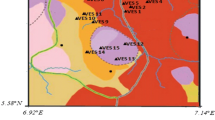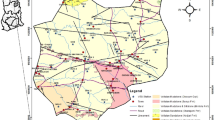Abstract
Scarcity of drinking water has been a major challenge in Edem, southeastern Nigeria. Thus, an electrical resistivity study was carried out in twenty-one locations across Edem, employing vertical electrical sounding. The study aims at investigating groundwater repositories through the estimation of aquifer geohydraulic parameters and corrosivity of the area. Resistivity, depth and thickness of each layer were realised after the measured resistivity field data were interpreted using manual and computer software packages. The results give a resolution of three to six geoelectric layers, with a total of nine generic curve types namely KQH, KHKH, KHK, AAK, AKQ, KHA, KH, KQQ and AKHK. The results show that the depth and thickness of the aquifer layer range from 39.2 to 161.3 m and 24.8 to 147.6 m respectively. Hydraulic conductivity values having a mean value of 2.1822 m/day range from 0.0121 to 14.0931 m/day. Values of transmissivity range from 0.8607 to 458.0727 m2/day and porosity ranges from 25.5831 to 32.6457%, while tortuosity ranges from 0.281 to 0.301. From the results, the fourth layer was identified as harbouring most of the aquiferous zones. Contour maps were generated to show the variations of the geohydraulic parameters across the area. Plots of these parameters show their good correlation coefficients. The result delineates 4.76% of the study area as corrosive and 76.19% as essentially non-corrosive while 9.52% are both moderately and mildly corrosive. This study will aid in divulging areas with higher groundwater potentials and areas with economical extraction of groundwater.







Similar content being viewed by others
References
Agbede OA, Aiyelokun OO (2016) Establishment of a stochastic model for sustainable economic flood management in Yewa Sub-Basin, southwest Nigeria. Civil Eng J 2(12): 646-654. https://doi.org/10.28991/cej-2016-00000065
Akpan AE, Ugbaja AN, George NJ (2013) Integrated geophysical, geochemical and hydrogeological investigation of shallow groundwater resources in parts of the Ikom-Mamfe Embayment and the adjoining areas in Cross River State, Nigeria. Environ Earth Sci 70(3):1435–1456. https://doi.org/10.1007/s12665-013-2232-3
Akpan FS, Etim ON, Akpan AE (2007) Geophysical studies of groundwater potential in parts of Etim Ekpo local government area, Akwa Ibom State. Nigeria J Physics 18:39–44. https://doi.org/10.4314/njphy.v18i1.38080
Aleke CG, Ibuot JC, Obiora DN (2018) Application of electrical resistivity method in estimating geohydraulic properties of a sandy hydrolithofacies: a case study of Ajali Sandstone in Ninth Mile, Enugu State, Nigeria. Arabian J Geosciences 11: 322. https://doi.org/10.1007/s12517-018-3638-8
Al-Khafaji WM, Al-Dabbagh HA (2016) Visualizing geoelectric-hydrogeological parameters of Fadak farm at Najaf Ashraf by using 2D spatial interpolation methods. Nriag J Astron Geophys 5:313–322. https://doi.org/10.1016/j.nrjag.2016.07.001
Archie GE (1942) The electrical resistivity log as an aid in determining some reservoir characteristics. Petroleum Transactions of the AIME 146:54–62
Chakravarthi V, Shankar GBK, Muralidharan D, Harinarayana T, Sundararajan N (2007) An integrated geophysical approach for imaging subbasalt sedimentary basins: case study of Jam river basin, India. Geophysics 72(6):141–147. https://doi.org/10.1190/1.2777004
Christensen NB, Sorensen KI (1998) Surface and borehole electric and electromagnetic methods for hydrogeological investigations. Eur J Environ Eng Geophysics 31:75–90
Ebong OE, Akpan AE, Onwuegbuche AA (2014) Estimation of geohydraulic parameters from fractured shales and sandstone aquifers of Abi (Nigeria) using electrical resistivity and hydrogeologic measurements. J African Earth Sci 96:99–109. https://doi.org/10.1016/j.jafrearsci.2014.03.026
Ekeleme AC, Agunwamba JC (2018) Experimental determination of dispersion coefficient in soil. Emerging Science Journal, 2(4): 213-217. https://doi.org/10.28991/esj-2018-01145
Ezema OK, Ibout JC, Daniel NO (2020) Geophysical investigation of aquifer repositories in Ibagwa Aka, Enugu State, Nigeria, using electrical resistivity method, Groundwater for Sustainable Development 11 https://doi.org/10.1016/j.gsd.2020.100458
Gemail KS, El-Shishtawy AM, El-Alfy M, Ghoneim MF, Abd el-bary MH(2011) Assessment of aquifer vulnerability to industrial waste water using resistivity measurements. A case study, along El-Gharbyia main Drain, Nile Delta, Egypt. J Applied Geophysics 75: 140-150. https://doi.org/10.1016/j.jappgeo.2011.06.026
George NJ, Nathaniel EU, Etuk SE (2014) Assessment of economical accessible groundwater reserve and its protective capacity in Eastern Obolo Local Government Area of Akwa Ibom State, Nigeria, using electrical resistivity method. Intl J Geophysics 7(3):693–700. https://doi.org/10.1155/2014/578981
George NJ, Ibuot JC, Obiora DN (2015) Geoelectrohydraulic of shallow sandy in Itu, Akwa Ibom State (Nigeria) using geoelectric and hydrogeological measurements. J African Earth Sci 110:52–63. https://doi.org/10.1016/j.jafrearsci.2015.06.006
Halek V, Svec J (1979) Groundwater hydraulics. Development in water science
Heigold PC, Gilkeson RH, CartwrightK RPC (1979) Aquifer transmissivity from surficial electrical methods. Ground Water 17(4):338–345. https://doi.org/10.1111/j.1745-6584.1979.tb03326.x
Hussain MR, Abed BS (2019) Simulation and assessment of groundwater for domestic and irrigation uses. Iraq. Civil Eng J, 5(9):1877-1891, https://doi.org/10.28991/cej-2019-03091379
Ibuot J, Akpabio G, George N (2013) A survey of the repository of groundwater potential and distribution using geoelectrical resistivity method in Itu Local Government Area (LGA), Akwa Ibom State, Southern Nigeria. Central Eur J Geosci 5(4):538–547. https://doi.org/10.2478/s13533-012-0152-5
Iloeje NP, (1995) A new geography of Nigeria Revised Ed. Longman Nig. Ltd. pp 45-50. https://doi.org/10.4236/am.2018.912088
Marotz G (1968) TechischeGrundlageneinerWasswerspeicherungImmnaturlichen UtergrundHabilitationsschrift. Universitat Stuttgart, Germany
Martínez AG, Takahashi K, Núñez E, SilvaY, TrasmonteG, Mosquera K, Lagos P (2008) A multi-institutional and interdisciplinary approach to the assessment of vulnerability and adaptation to climate change in the Peruvian Central Andes: problems and prospects. Adv Geosci 14:257–260. hal-00297107f
Martys NS (1999) Diffusion in partially-saturated porous materials. Mater Struct Materiaux et Constructions 32:555–562
Mortezaei H, Karimpour-Fard M (2017) Variation of the hydraulic conductivity of clayey soil in exposure to organic permeants. Guilan, Iran. Civil Eng J 3(11) 1036- https://doi.org/10.28991/cej-030936
National Population Commission Census (2006) Report on Nigeria national population commission. JSTOR 33:206–210. https://www.jstor.org/stable/25434601
Niwas S, Singhal DC (1981) Estimation of aquifer transmissivity from Dar-Zarrouk parameters in porous media. J Hydrol 50:393–399. https://doi.org/10.1016/0022-1694(81)90082-2
Obiora DN, Ibuot JC (2020) Geophysical assessment of aquifer vulnerability and management: a case study of University of Nigeria, Nsukka, Enugu State. Appl Water Sci 10:29. https://doi.org/10.1007/s13201-019-1113-7
Offodile ME (1983) The occurrence and exploitation of groundwater in Nigeria basement complex. J Mining Geology. 20:131–146
Ofomata GEK (1967) Some observations on relief and erosion in Eastern Nigeria. Revue deGeomorph, Dynamise. XVU, pp. 21-29.
Roberge PR (2000) Handbook of corrosion engineering. McGraw-Hill. ISBN:9780071750370
Roscoe MC (1990) Handbook of ground water development. John Wiley and Sons, New-York. ISBN 10: 0471856118/ ISBN 13: 9780471856115
Shen L, Chen Z (2007) Critical review of the impact of tortuosity on diffusion. Chem Eng Sci 62(14):3748–3755. https://doi.org/10.1016/j.ces.2007.041
Singh KP (2005) Nonlinear estimation of aquifer parameters from surficial resistivity measurements. Hydro Earth System Science 2: 917–930. HAL Id : hal-00298656
Soupios PM, Kouli M, Vallianatos F, Vafidis A, Stavroulakis G (2007) Estimation of aquifer hydraulic parameters from surficial geophysical methods. A case study of Keritis Basin in Chania (Crete-Greece). J Hydrol 338:122–131. https://doi.org/10.1016/j.jhydrol.2007.02.028
Todd DK (2004) Groundwater hydrology, (2nd Ed.). John Wiley, New York. ISBN 10: 047187616X / ISBN 13: 9780471876168
Ugwuanyi MC, Ibuot JC, Obiora DN (2015) Hydrogeophyical study of aquifer characteristics in some parts of Nsukka and Igbo Eze south local government areas of Enugu State, Nigeria. Intl J Physical Sci 10(15):425–435. https://doi.org/10.5897/IJPS2015.4373
Zohdy AAR, Eaton GP, Mabey DR (1974) Application of surface geophysics to groundwater investigation. USGS Techniques of water resources investigations, Book 2, Chapter D1.
Acknowledgements
We are grateful to Chief and Lolo J.M. Omeje for all your contributions and encouragement throughout this research. May God Almighty bless You all.
Author information
Authors and Affiliations
Corresponding author
Ethics declarations
Conflict of interest
The authors declare that they have no competing interests.
Additional information
Responsible Editor: Narasimman Sundararajan
Rights and permissions
About this article
Cite this article
Omeje, E.T., Ugbor, D.O., Ibuot, J.C. et al. Assessment of groundwater repositories in Edem, Southeastern Nigeria, using vertical electrical sounding. Arab J Geosci 14, 421 (2021). https://doi.org/10.1007/s12517-021-06769-1
Received:
Accepted:
Published:
DOI: https://doi.org/10.1007/s12517-021-06769-1




